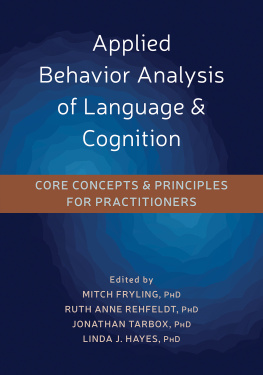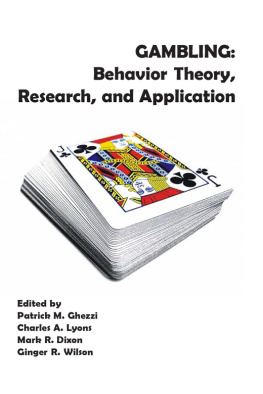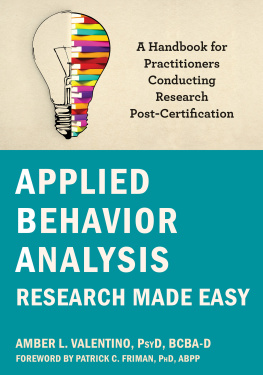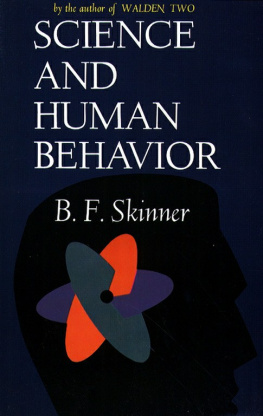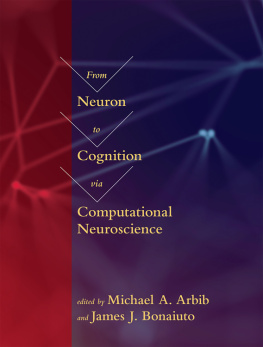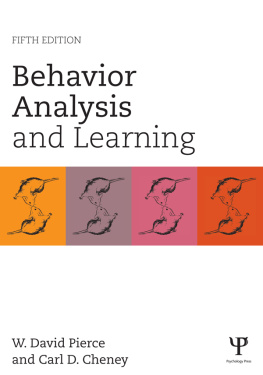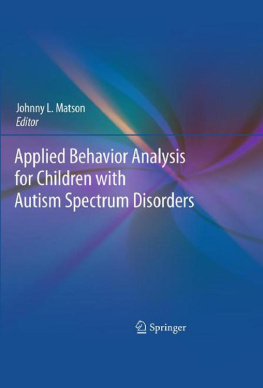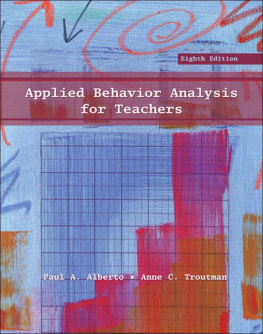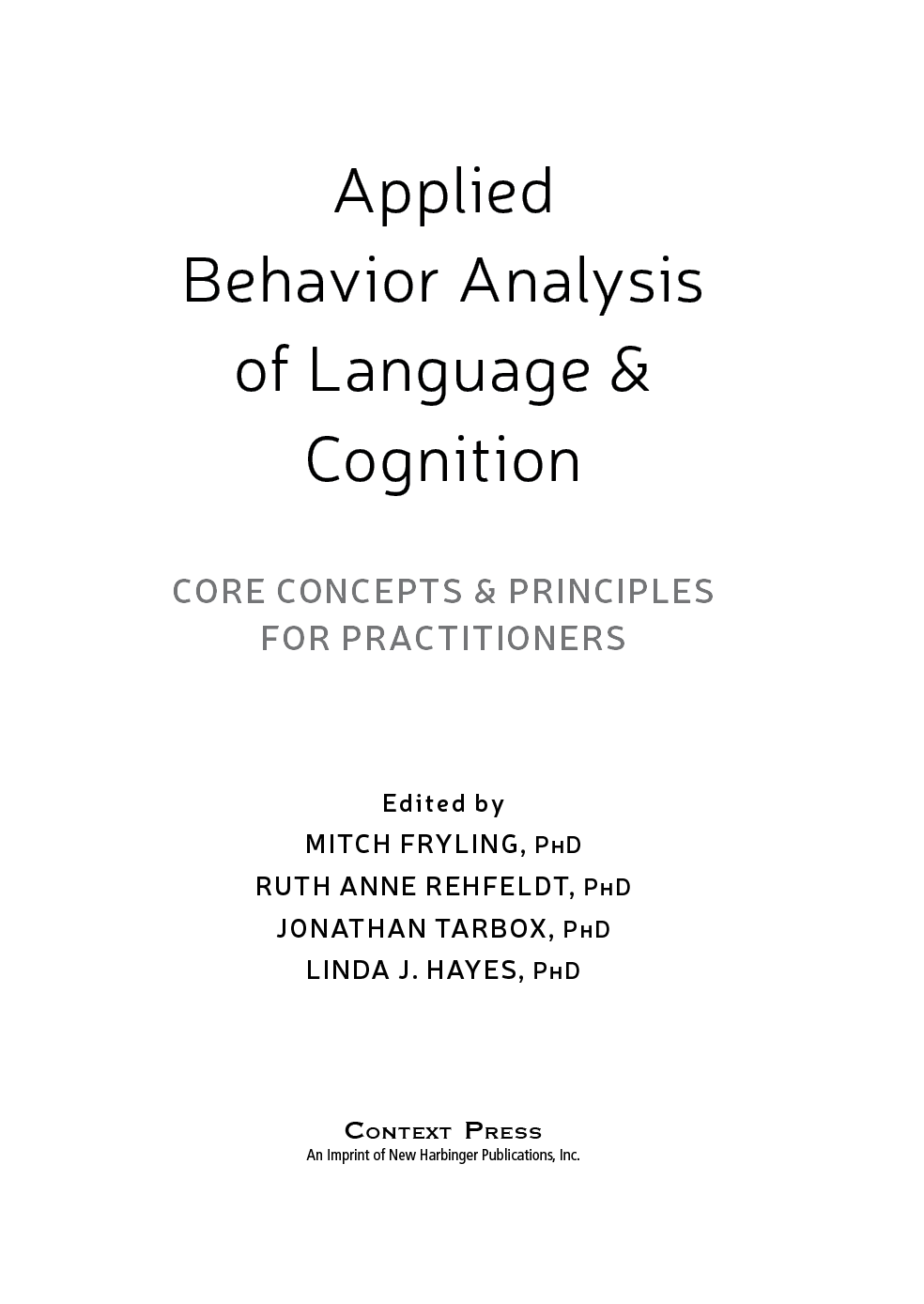This is an outstanding volume with a star-studded lineup of editors and authors, with strong credibility in behavioral science and its progression. The editors mount a compelling case for the merits of behavioral science as an academic and applied field, and one in which these integrate coherently. For authors or students wishing to update on what behavior analysis has done since Skinner, this volume is a must. While it is dense and accurate, it is readable and digestible. An excellent addition to a complex area of psychology, but one which the editors and authors convince us is worth grappling with.
Yvonne Barnes-Holmes, PhD , associate professor in behavior analysis, and senior research fellow at Ghent University
A truly remarkably and needed book that provides a comprehensive analysis of fundamental behavioral processes and contemporary theory, research, and practice published in the areas of language and cognition. It synthesizes Skinners analysis of verbal behavior with contemporary relational frame theory (RFT), and progressively introduces important core concepts such as stimulus equivalence classes, response generalization, referencing, perspective taking, problem-solving, and rule-governed behavior. Acceptance and commitment therapy (ACT) is presented as a contemporary behavior analytic therapy that addresses the implications of the science of language and cognition for practice and instruction of applied behavior analysis. This book should be required reading in every graduate program in psychology and behavior analysis.
Martha Pelaez, PhD , professor in the department of educational psychology at Florida International University
I highly recommend this book to academicians, researchers, and scientific practitioners who are interested in the advancement and application of behavior science. Central threads in behavioral accounts of sociocultural phenomena highlight communication, and ways language plays a fundamental role in human behavior. The selection of chapters coedited by Fryling, Rehfeldt, Tarbox, and Hayes illustrate the power of behavior science and collective abilities of our scientific group to respond to the emerging opportunities for scientific impact. In that regard, the authors lay substantial groundwork for the advanced analyses of language and cognition with workable implications for development and dissemination of associated technologies.
Ramona A. Houmanfar, PhD , professor in the department of psychology, and director of the behavior analysis program at the University of Nevada, Reno
Publishers Note
This publication is designed to provide accurate and authoritative information in regard to the subject matter covered. It is sold with the understanding that the publisher is not engaged in rendering psychological, financial, legal, or other professional services. If expert assistance or counseling is needed, the services of a competent professional should be sought.
Distributed in Canada by Raincoast Books
Copyright 2020 by Mitch Fryling, Ruth Anne Rehfeldt, Jonathan Tarbox, and Linda J. Hayes
Context Press
An imprint of New Harbinger Publications, Inc.
5674 Shattuck Avenue
Oakland, CA 94609
Cover design by Amy Shoup
Acquired by Ryan Buresh
Edited by Rona Bernstein
Indexed by James Minkin
Figure 16.1. is used by permission from Springer Nature. Adaptation of Derived Stimulus Relations and Their Role in a Behavior Analytic Account of Human Language and Cognition; Barnes-Holmes, Finn, McEnteggart et al; Perspectives on Behavior Science . Copyright January 1, 2017.
All Rights Reserved
Library of Congress Cataloging-in-Publication Data on file
Contents
Chapter 1:
An Introduction to Applied Behavior Analysis of Language and Cognition
Linda J. Hayes
University of Nevada, Reno
Progress toward a natural science of behavior has been delayed by a number of difficulties. The first of thesethe attribution of causal status to nonmaterial entitieshas been overcome by the exclusion of hypothetical, nonnatural elements and their powers from the events making up the subject matter of a science of behavior (Kantor, 1924). While not all behavior scientists have forfeited the right to postulate unobserved entities for purposes of explanation, the need for such entities and their forces is proportional to the absence of information derived from observational sources. Hence, advances in observational methods and technologies may be expected to make such distractions increasingly unnecessary.
A second difficulty pertains to the definition of a unit behavioral event. The units of analysis problem has been resolved, for the most part, by sacrificing the uniqueness of individual responses for the affordances of response class constructions. More than one such unit has been proposed, though Skinners (1938) concept of the operant has proven particularly valuable. The criteria proposed by Skinner for the membership of responses in operant classes included their conditions of occurrence, a provision enabling not merely prediction but also control over class member occurrences. Further, because prediction and control of class member occurrences are more readily demonstrated when such occurrences are taking place at high frequencies, Skinner (1953) proposed that preliminary investigations focus on simple responses of arbitrary form that could occur at high frequencies without significant fatigue for extended periods of time. The notion was that this preparation would permit for the development of laws and principles of behavior that, subsequently, would be applicable to more complex, nonarbitrary forms of responding. With this aim and upon this premise, the science of behavior proceeded.
The absence of sophisticated observational technologies at the time of these developments placed severe limitations on the automated detection of even simple responses, however, representing a third factor delaying progress of the natural science of behavior. Automated detection of responses demanded that they be localized on particular mechanical operanda (e.g., levers, keys), the operations of which were substituted for measures of responding. As a result, the nuances of individual responses fell below the threshold of instrumental precision. Still, Skinners experimental preparations (e.g., Skinner, 1938; Ferster & Skinner, 1957) resulted in a corpus of principles (e.g., stimulus control, reinforcement, extinction) that proved applicable to the behavior of a wide variety of species and led to the development of a powerful technology of behavior change presently being employed in many domains of human activity. All the research presented in this volume, with the exception of that in chapter 7 by Emilio Ribes, rests on a foundation of the principles of behavior as construed by Skinner.
Challenges Related to the Subject of Behavior
The promise of an experimental analysis of unrestricted, nonarbitrary forms of responding, and their elaboration into more complex forms, has not been fully realized. For the most part, this circumstance is owing to the subject matter of behavior science. Behavior has a number of features that complicate its scientific investigation. In the first place, behavior is not a thing localizable in an organism, but is rather a function resulting from responding and stimulating, taking place in a field of many other factors. As such it is not possible to identify or classify behavior in the absence of information about the setting in which it is occurring. Measurement practices thereby must be capable of capturing functional relations between behavior and environmental variables, not merely the occurrence of responses with particular formal properties.

